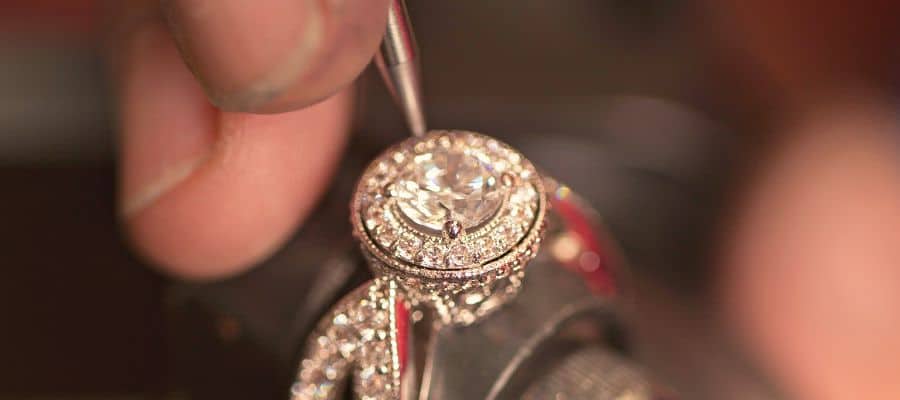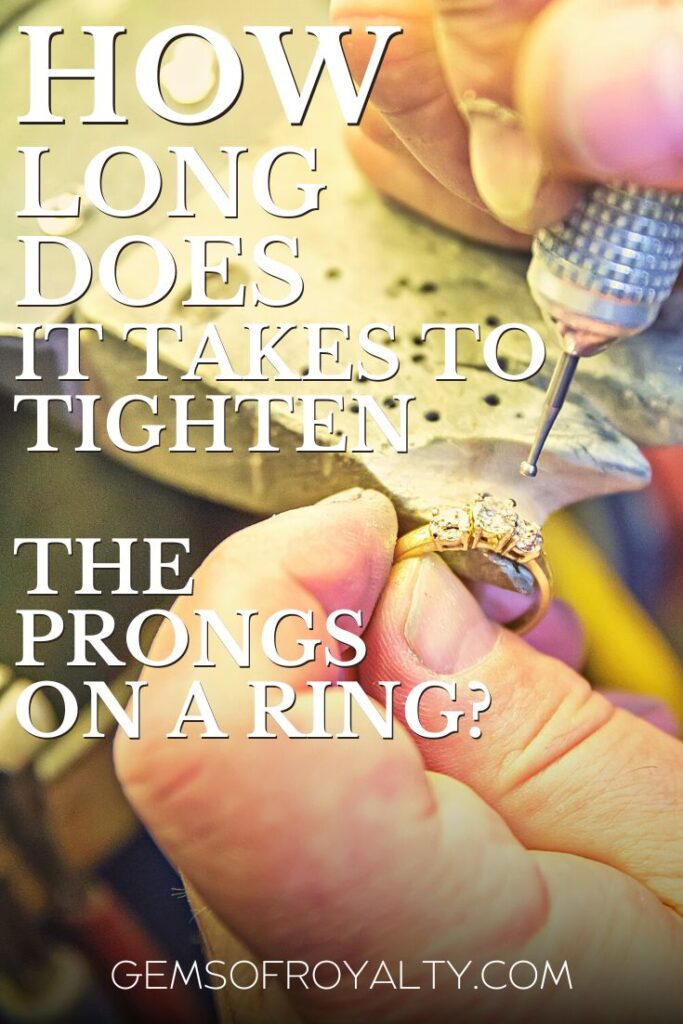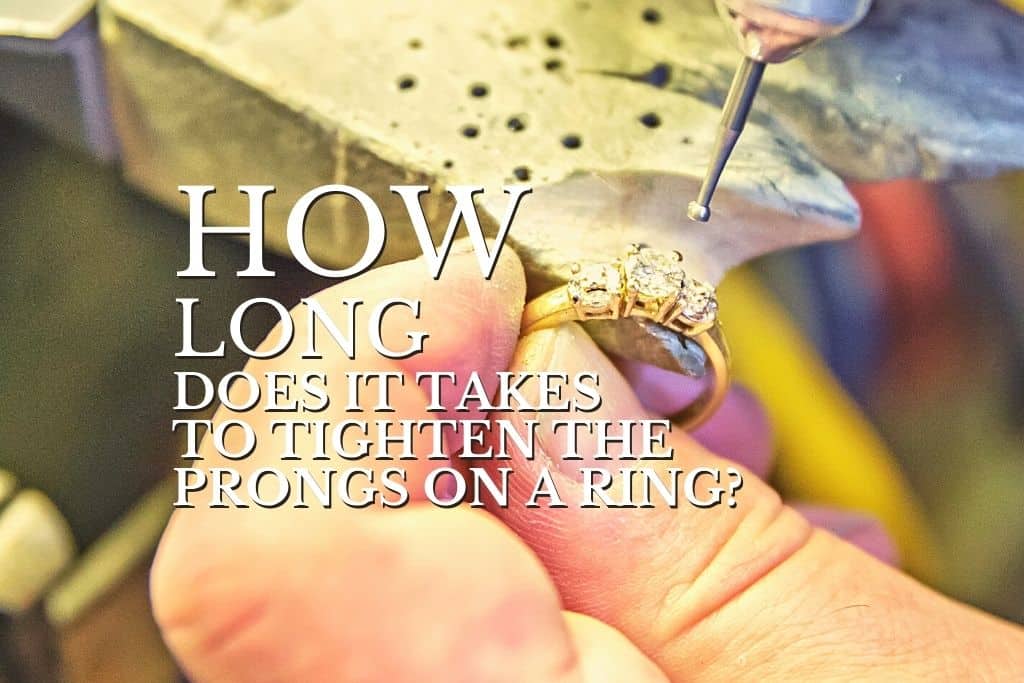We love our jewelry (rings in particular) for its beauty and the memories they hold. So when you notice your rock has become loose, you want to have the prongs tightened by a pro.
It takes around 1–2 days to tighten the prongs on a ring by a trained jeweler. The time depends on the location, severity of the repair, size, and shape of the stone. Prongs will naturally get loose over time, but there are practices to limit the damage.
In the rest of the articles, I’ll expand on the factors affecting the job’s speed and ways to avoid adding to your ring’s wear and tear.
Factors That Determine How Long It Takes To Tighten Ring Prongs

A handful of elements will change the speed of your ring’s prong repair.
As I mentioned before, how intricate the job is, the size and shape of the gemstone, and its location can influence how long it takes to tighten the prongs on a ring. However, it’s essential to understand what goes into this process.
Your average ring is made up of four major parts. The prongs are tiny metal claws that hold the stone in place. They typically come with four or six pieces (six being more secure). These prongs are fragile and may break down with time.
Tightening a loose prong is routine for any experienced jeweler and typically not too difficult. But there are a few factors that affect how long it takes:
The Severity of the Job
While typically a simple job, it depends on which prong is loose or how much damage is done. Although you might be looking for a quick tightening, you might learn that your ring requires actual repairs, which can add to the time needed to finish the job.
If the shop you go to isn’t busy, and there are no other repairs to be done, you may even get your ring back on the same day.
Size and Shape
As the prong’s job is to match the shape to hold the stone securely, the stone’s cut and size will affect the job’s difficulty. Tightening requires setting pliers and a steady hand. Finding an experienced jeweler to perform it is essential, or you risk damaging your prongs more or even chipping the stone itself.
Location
Where you take your ring to be repaired is just as crucial as who’s fixing it. Often, if you return to the place you purchased your ring, they can offer tightening for free with even same-day returns.
If your ring needs more repairs, the jeweler may be required to order parts or even ship the ring out to be fixed, which can add to repair time. Independent jewelry stores are the way to go if looking for a quick turnaround time since their stores typically have on-site jewelers.
Time of year can also play a factor, with stores becoming busier during the holidays (Christmas in particular).
How To Protect Your Rings

While the prongs in your ring are bound to get loose over time, you can still follow some crucial practices to slow down that process as much as possible.
Get Ahead of It
Like keeping your body healthy, the best practice to avoid losing a pricey diamond is being preemptive with your care. Taking your jewelry in for routine examinations, professionals keep an eye out for potential damage and fix it before any major repairs are required.
The recommended time for taking your ring in for checkups is around every six months if you wear it daily. It’s possible to inspect your jewelry personally with the proper tools and knowledge if you don’t have a trusted jeweler to visit.
Take It Off
It may not seem like it, but plenty of our everyday routines can add irreversible damage to your favorite rings. Knowing when you need to remove your jewelry makes a world of difference in terms of longevity.
Taking off your ring before sleeping, swimming or cleaning is the best course of action.
While it might not seem like much, sleeping with your rings is one of the worst things you can do for their lifespan. The sheets of your bed run a high risk of wearing down the prongs of your ring, leaving the gemstone unprotected. The pressure you apply to the ring in your sleep might also tear your sheets.
Our fingers also tend to swell in our sleep. This means you risk your ring getting stuck and having a tough time removing it.
Both saltwater and chlorine are known to damage jewelry. Chlorine, in particular, can discolor metals like gold and platinum while also eroding the polish of gemstones.
Bleach-based cleaning products also can cause significant erosion to your jewels. These harsh chemicals can get stuck under your ring, leading to skin irritation.
Removing your rings during strenuous or outdoor activities is also good practice. Sweat can cause shifting or your ring to fall off entirely. The last thing you want is to damage or lose your ring while enjoying a sport or traveling.
Warranty
Note that many locations offer a free warranty. Still, even if they don’t, getting your jewelry insured is ideal. While beautiful, rings can be very fragile. Protecting against damage, loss, or theft will do wonders for your peace of mind.
The cost of stones like diamonds changes over the years, and ensuring your gemstones are appraised is the only way to protect your investment.
Conclusion
On average, it takes a veteran jeweler 1–2 days to tighten the prongs on a ring. However, this repair time can be affected by
- The severity of the repair
- The size and shape of the gemstone used
- What kind of jewelry stores do you visit
Getting the prongs on your ring tightened is a vital maintenance routine to avoid long-term damage.
While there are plenty of options for tightening or fully repairing your ring, the best course of action is to keep it from needing repairs in the first place.
If you found this article useful, make sure you save this pin below to your Jewelry board.


